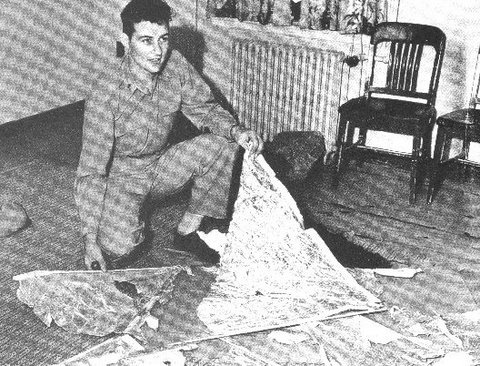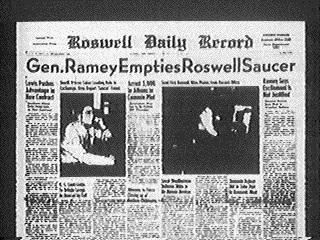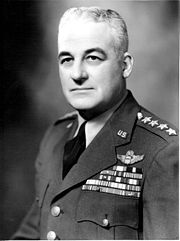
|
The
 Irving
Newton (above) was later brought in and told by General Ramey to
identify the debris as a "weather balloon" for the press corp. Back to the Time Line The following incidents occurred between 3:00 and 5:00 p.m. on Tuesday July 8, 1947. Brigadier General
Roger Ramey announces that "the
flying disc has been sent to Wright-Patterson Air Base in General Clements
McMullen calls Colonel DuBose from Major Jesse Marcel learns that he will transport the debris on a specially prepared B-29 airplane heading for Fort Worth Army Air Field. Marcel describes the load of debris as "half a B-29 full." (Note: There was no weather balloon ever made that can fill half of a B-29 bomber.) Meanwhile, back at the debris field, army personnel are continuing to fill wheelbarrows with debris and load it on to trucks. Around 5:00 p.m. the Pentagon calls Roswell Army Air Base and orders a halt to all press releases. More Photos About 5:30 p.m., two
hours after Jesse Marcel left
General Ramey' s office, Ramey summoned a young weather officer, Irving
Newton,
to his office. In the first photos
taken of Dubose and Marcel with the
real debris you can clearly see Marcel s military cap and tie lying on
the
radiator in the background. The photo of One More Press Conference At 8:00 p.m. Roger Ramey calls a press conference. He tells the press that he, (a brigadier general in charge of an air base and air command unit who had personally handled the debris for hours) made a mistake and misidentified what turned out to be a common weather balloon. At 10:00 p.m. ABC News
declares the
Wednesday, July 9, 1947 Alien bodies and a
crashed disc are flown to
Wright-Patterson Air Base. All parties who were
at Also keep in mind the number of high-level personnel involved. They were all colonels and generals who were stationed at the most sophisticated air base operation in the world. They had just finished fighting World War II, and they were experts in radar arrays and weather balloons. How could all these high-level people be involved in such a great amount of activity over an entire week for something they saw everyday, namely weather balloons? Why would a group of
civilians all get together and
decide to lie in concert for no monetary gain about what they saw at Fact: Mac Brazel, the rancher who originally found the debris field, was taken into custody and held by the military for a week. You think they held the guy for a week for finding a weather balloon? C'mon, get real! Brazel had found weather balloons on his ranch many times before and nobody came out to look at them, and nobody ever asked him to return them. Mac Brazel's son Bill
lived seventy-five miles away in Here's how Bill Brazel recalls the whole affair: "My dad found this thing and he told me a little bit about it. Not much, because the Air Force asked him to take an oath that he wouldn’t tell anybody in detail about it." "Then, lo and behold, here comes the military. They said we understand you found some bits and pieces." I said "Yeah" and he said, "Your father turned the rest over to us, and you know he is under an oath not to tell." And he said, "We would rather you didn’t talk very much about it." Twining Takes a Trip Several days later on
July 17, 1947 General Nathan
Twining cancels a preplanned trip. Instead, he makes an emergency trip
in the
middle of July, with no air conditioning, to, you guessed it!
|


